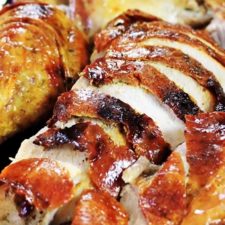Citrus and Herb Dry-Brined Roasted Turkey
Your folders
Your folders
Prep Time: 24 hours
Cook Time: 1 hours, 25 minutes
Total: 25 hours, 25 minutes
Servings: 10
Author : Chef Resha

Ingredients
Export 19 ingredients for grocery delivery
Instructions
Step 1
Rinse your bird thoroughly, pat dry with paper towels.
Step 2
Using super sharp kitchen shears, cut out the backbone and save it for the gravy along with the giblets.
Step 3
Flatten the breast meat down, using all of your weight, or a heavy cast iron skillet or pot to assist you. You want the bird in one even flat layer so it roasts evenly.
Step 4
Separate the skin from the meat of the turkey and massage some of your salt mixture onto the inside of the flattened bird, and under the skin.
Step 5
Sprinkle plain kosher salt all over the skin of the turkey. It shouldn’t be encrusted in salt, just a good even layer. Get all in the nooks and crannies. If you’re roasting the bird within the next 24 hours, do not cover it before you refrigerate it. This will allow the skin to dry out and roast up nice and crispy. If you’re cooking the bird in 2-3 days, keep it covered with plastic wrap (loosely) during that time to prevent excess moisture loss. Remove the plastic during the last 12-24 hours though.
Step 6
Remove the turkey from the fridge 1 hour before you’re ready to roast it, so that it comes to room temperature.
Step 7
Preheat your oven to 450 degrees. Line a baking sheet with foil and scatter some random aromatics (garlic, onion, celery, carrot, fresh herbs, citrus) just to give the turkey a bed to lay on so that the bottom doesn’t burn. Rub the skin with olive oil.
Step 8
Place turkey in the oven and roast until an instant-read thermometer in the breast meat registers 150 degrees, and the dark meat registers 165 degrees, about 80-90 minutes. Quick note: Adjust oven temperature if your bird is browning too quickly. Start at 450 degrees, but if after 45 minutes, it’s getting too dark, reduce the heat. Cooking times will vary on the size of your bird, how hot your oven is, etc. Check the temperature after an hour. This is why a thermometer is SO important. A turkey with 150 degree breast meat is perfectly safe to eat if rested properly. Remove the bird once it’s at 145/150 and let it rest. It will continue to “cook” out of the oven, and the internal temperature will rise another 10 degrees or higher, depending on the bird. So resting is SUPER important for safe eats.
Step 9
Let the bird rest for one full hour before carving.
Step 10
Saute the backbone and neckbone in olive oil until browned, about 7 to 10 minutes.
Step 11
Add aromatics and cook an additional 4-6 minutes or until veggies have softened slightly. You can do this in a skillet and then transfer to a saucepan or you can do this in a saucepan from the start. Add enough chicken stock to cover the mixture, add fresh herbs and bay leaves, and bring to a boil. Reduce heat and simmer uncovered for 40-45 min or until visibly reduced. Strain mixture into a measuring cup or bowl along with 1/2 cup of the turkey drippings.
Step 12
Melt the butter and oil in a saucepan, and add a heaping 1/4 cup of flour. Whisk for about two minutes to allow flour to cook out.
Step 13
SLOWLY add 2 cups of the hot broth mixture, a little at a time, whisking vigorously to avoid lumps.
Step 14
Reduce heat to low and allow to simmer and thicken for about 5 minutes. Add a tiny splash more of the cooking liquid if your gravy is too thick. Give it a taste and adjust seasoning.
Step 15
Add a splash of Crown Royal Maple Cognac (or any liquor) and cook an additional minute or two.
Step 16
Serve with the turkey.